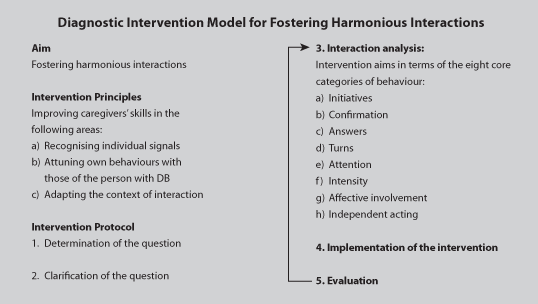
Profile: The intervention programme CONTACT
Fostering harmonious interactions in children with congenital deafblindness.
The intervention programme CONTACT was developed at Royal Dutch Kentalis, the Netherlands, in order to enhance the quality of interaction between children with congenital deafblindness and their educators. In the meantime, this programme is used in different support facilities with different target groups, and it serves as a basis to foster high quality interpersonal communication. In this profile the intervention model is described.
The intervention model serves as a basis for the intervention programme. The model is called the Diagnostic Intervention Model for Fostering Harmonious Interactions (as shown in Table 1). The interventions are focused on improving the insight and skills of educators in the following areas: a) recognising individual signals, b) adjusting their own behaviour to that of the person with deafblindness and c) adapting the interaction context.
The entire procedure – from the moment that an education-related question arises until the problem is resolved – is established in a protocol. The protocol is a cyclical model in which the problem is resolved in various phases. One important component of interaction analysis is the formulation of the intervention aims in terms of eight core categories: initiatives, confirmation, answers, turns, attention, intensity, affective involvement and independent acting. (For the definitions of the categories, see Janssen, Riksen-Walraven & Van Dijk, 2003-2010).
The intervention begins as soon as the aims have been determined. Interventions are carried out by multiple educators (e.g. teachers, caregivers and parents) in a variety of settings (school, living group and at home). The educators are coached both individually and as a team by a communication coach. The most important tool for the coaches is video analysis. Each session lasts for 90 minutes. The aims are evaluated using video analysis to observe the core categories after a previously established period. A decision is then made to either terminate the intervention or continue with adjusted aims.
Implications for practice
The intervention programme CONTACT has been successfully implemented in daily practice for six children with congenital deafblindness and their fourteen educators. Implementation needs an on-going investment in training of communication coaches and in time for coaching of the educators. Over the years, the intervention programme CONTACT was expanded with a communication phase after the interaction phase by the research group at the University of Groningen. In this communication phase, educators are coached to stay focused on the behaviour and emotions of the person with deafblindness and, at the same time, to try to improve sharing of meanings and mutual understanding. The first results are now published (Damen, Janssen, Huisman, Ruijssenaars & Schuengel, 2014; Martens, Janssen, Ruijssenaars & Riksen-Walraven, 2014a; and Martens, Janssen, Huisman, Ruijssenaars & Riksen-Walraven, 2014b).
Horizon 2020
The Horizon 2020 programme is important for funding longitudinal, communication-coaching research. To prove that this method works in different cohorts of people with deafblindness, while new theories are tested, further research in everyday practice is needed with babies, school children and adults who are deafblind.


Prof Dr Marleen Janssen
University of Groningen
Department of Special Needs Education and Youth Care
Congenital and Early Acquired Deafblindness
tel: +31503636575
[email protected]
www.rug.nl/staff/h.j.m.janssen
www.kentalis.nl





